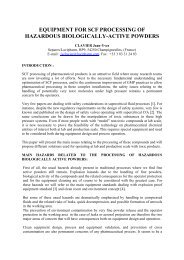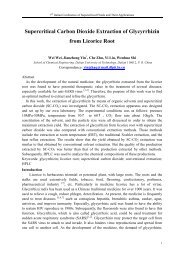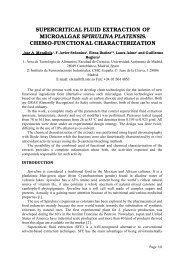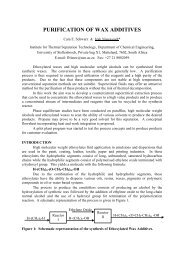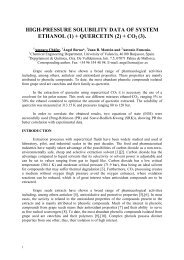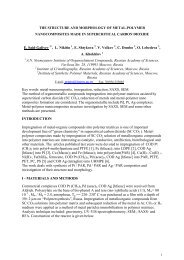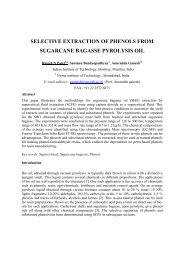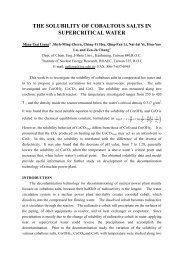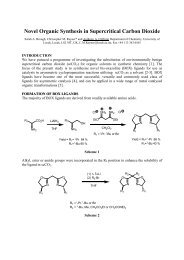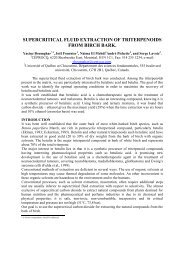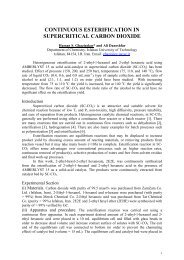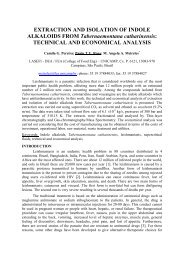REGENERATION OF GAC-F400 BY SCCO2: EFFECT OF ... - ISASF
REGENERATION OF GAC-F400 BY SCCO2: EFFECT OF ... - ISASF
REGENERATION OF GAC-F400 BY SCCO2: EFFECT OF ... - ISASF
You also want an ePaper? Increase the reach of your titles
YUMPU automatically turns print PDFs into web optimized ePapers that Google loves.
Mass desorbed, mg<br />
300<br />
250<br />
200<br />
150<br />
100<br />
80 bar 100 bar 135 bar<br />
175 bar 210 bar 250 bar<br />
285 bar<br />
Mass desorbed, mg<br />
300<br />
250<br />
200<br />
150<br />
100<br />
80 bar 100 bar 135 bar<br />
175 bar 210 bar 250 bar<br />
285 bar<br />
50<br />
50<br />
0<br />
0 50 100 150 200<br />
time, min<br />
Figure 3: The effect of pressure on the<br />
supercritical desorption rate in caprolactam /<br />
<strong>GAC</strong>-<strong>F400</strong>, at 25 ºC.<br />
0<br />
0 50 100 150 200<br />
time, min<br />
Figure 4: The effect of pressure on the<br />
supercritical desorption rate in caprolactam /<br />
<strong>GAC</strong>-<strong>F400</strong>, at 40 ºC.<br />
Clearly, at 25ºC (subcritical T) the desorption rate is ‘less sensitive’ to pressure changes than<br />
at 40ºC (supercritical). Above T c (31ºC), the CO 2 density (and hence solvating power) is<br />
highly sensitive to changes in pressure the factor that is responsible for the ‘tunability’ of SCF<br />
properties in that operation region. This is shown in the ‘wide spread’ of desorption rates in<br />
Figure 3. Typically, the desorption curves are not linear with time, indicating the effect of<br />
intraparticle diffusion within the <strong>GAC</strong> particles, which is a function of time and position or<br />
location of caprolactam molecules within the <strong>GAC</strong> particles.<br />
The effect of temperature and pressure: Figures 5 and 6 show the maximum desorbed<br />
amount of caprolactam as function of pressure and temperature, respectively. For a given<br />
system, the maximum desorbed amount is a balance of two factors, namely the solvent<br />
density and the vapour pressure of the solute. At lower pressures, increasing the temperature<br />
reduces the solvent density and hence its activity (power). Higher pressures enhance the<br />
solute vapour pressure (volatility) to an extent that overcomes the reduction in solvent density<br />
inflicted by elevated temperatures. Hence the effect of temperature ‘reverses’ above a certain<br />
pressure, generally termed as the ‘crossover pressure’. Figure 4 shows that the crossover<br />
pressure is about 200 bars, below which low temperature operation is favoured, while high<br />
temperature operation is required above.<br />
250<br />
250<br />
Max desorbed, mg<br />
200<br />
150<br />
100<br />
50<br />
0<br />
25 deg C<br />
40 deg C<br />
50 deg C<br />
60 deg C<br />
70 deg C<br />
50 100 150 200 250 300<br />
Presure, bar<br />
Figure 5: The effect of pressure on the<br />
maximum mass desorbed in caprolactam /<br />
<strong>GAC</strong>- <strong>F400</strong> system at various temperatures.<br />
Mex desorbed, mg<br />
200<br />
150<br />
100<br />
50<br />
0<br />
80 bar<br />
100 bar<br />
135 bar<br />
175 bar<br />
210 bar<br />
250 bar<br />
285 bar<br />
20 40 60 80 100<br />
Temperature,C<br />
Figure 6: The effect of temperature on the<br />
maximum mass desorbed in caprolactam /<br />
<strong>GAC</strong>- <strong>F400</strong> system at various pressures.



